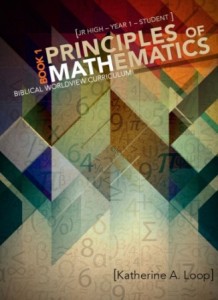
I love math. And actually, all of my children love math, too. I’ve been blessed with good math genes, apparently, and have hardly taught math to any of them their entire lives — they just get it, if that makes sense.
So when it comes to math education in our house, it’s a simple plan. “Here’s your math book. Have half of the tests done before Christmas and the rest finished before summer break. Let me know if you have any questions.” There’s rarely any questions.
But I have to tell you, I’ve never had a book to hand them that I just loved. We use Saxon math because it works for us, but it’s lacking one key component to their math education — a biblical worldview.
Some homeschoolers like to scoff at that, claiming worldview doesn’t matter when we talk about math. But that’s just not true. We are all careful to give a science, history, literature, and logic education from a biblical worldview, but for some reason we tend to think that the very laws God uses to hold the universe together are not worth studying from His perspective. It makes no sense.
For instance, when we taught our early learners the days of the week, remember how we pointed back to Genesis? We remind our young children that God promised to bring the sunshine every day and the seasons every year, but then we stop teaching the foundations of math right there, like the rest of the laws don’t matter. But we use them every day, and they do matter.
 So Katherine Loop wrote a curriculum to help us make this right. Principles of Mathematics: Biblical Worldview Curriculum teaches the foundational junior high (middle school) mathematics in two years. By completing this course, students will be prepared for Algebra I and will have a firm grasp of why math works the way God designed it to.
So Katherine Loop wrote a curriculum to help us make this right. Principles of Mathematics: Biblical Worldview Curriculum teaches the foundational junior high (middle school) mathematics in two years. By completing this course, students will be prepared for Algebra I and will have a firm grasp of why math works the way God designed it to.
Listen to author Katherine Loop explain why this is important.
The year 1 curriculum is designed for sixth or seventh grade students and comes in two books. The student text explains each day’s lesson in just a couple of easy-to-read pages with illustrations, diagrams, and examples. The companion workbook contains lesson schedules to plan the curriculum for completion in one year or one semester; worksheets for each day’s lesson; quizzes and tests; and answer keys that explain how the student should arrive at the answer.
I felt confident when I opened the curriculum, having completed calculus, statistics, and a semester of college math before graduating high school and having prepared my own son for exceptional ACT grades in math. But Katherine blew me away with this text. Each chapter begins with the foundational (ok, easy) idea, then she gradually builds upon it with layers of detail, explanation, real-world examples, and historical background. As a result, the student will find himself doing complex equations and applications without realizing others find that work quite difficult.
Each day’s assignment is surprisingly short, too. The student is required to read only a couple of pages and fewer than two dozen problems. There is a review lesson each chapter that is still surprisingly brief. In fact, my only question at first glance was is there enough review, but when I looked more closely at the way the lessons developed, I realized that Katherine designed the later problems to use earlier skills without calling them review. So the students won’t lose any skills over time, just become more proficient in using math principles in different ways.
You can preview the book and workbook here.
What I admired most about Katherine’s earlier book Revealing Arithmetic was her emphasis on creativity in problem solving. She emphasized through historical examples and problem solving diagrams that God’s principles hold true no matter how we work the equations on paper. That is an important lesson for students who get caught up in finding the one right way to solve a problem. I was glad to see this curriculum encourages students to work problems the way that is best for them while respecting the many expressions of God’s principles. Katherine talks about this more in her article here.
Unfortunately, I was unable to use this curriculum immediately — my junior high student halfway through his prealgebra already, and my younger student is not quite ready for this pace. But I can tell you this — I will use this curriculum with excitement in a couple years.
Principles of Mathematics by Katherine Loop is published by Master Books and is available from their website as well as on Amazon and other bookstores.
Disclosure: I received a copy of this curriculum from the author for my own consideration. These opinions are my own. Affiliate links help support this site.



Wow! Interesting.
Thanks for review. I’m new to home schooling and considering this for my two boys, grade 6 and grade 7. Would you take a break from your Saxon maths and then return to it after they’ve completed this series? Or is their a good point in Saxon to slot these in?
Amy
Amy,
I’m actually doing just that. My 13 year old finished Saxon 8/7 last year, so he should be starting Algebra 1 this year. But I learned from my older two children that sometimes eighth graders are totally ready for algebra . . . but sometimes they need another year for their brains to grow. I powered through it with my oldest, but when he hit that growth spurt suddenly it all made sense and he breezed through all his high school math effortlessly (and is now pursuing a mathematics degree in college).
So I’m waiting for that mental change for my middle guy. While I’m waiting, I’m using these books with him. He’ll do book 1 in only 1 semester or less (it should be mainly review) and do book 2 the second half of the year. These books present the information in a more practical “here’s how it applies to your life” way than Saxon does (in spite of the newer editions attempt to do more real-world problems, it seems to rarely apply to our actual lives).
When he’s done with that, I imagine we will use Saxon Algebra 1 for his freshman year of high school.
I would NOT use them both together. Saxon is pretty grueling (and I’m saying that as a life-long Saxon lover), and the entire point of this curriculum is to take a lot of the work out of math and get down to the basics — what can we learn about God, how does that look in creation and our daily lives, and how do we communicate these truths numerically.
Thanks Lea Ann
Really appreciate your thoughts and experience. I think I’ll do the Same with my son.
Amy
We have used Saxon since third grade. My daughter is now a 7th grader, and she’s wanting a break from the rigor of Saxon for a year. I’m impressed with Principles of Mathematics 1 for her, but wanted to see if you had any updated thoughts after going through the curriculum? Thanks for your help!
Did you end up using PoM 1? How is it working out? My rising 7th grader doesn’t find any joy in math but is very smart. I am wondering if this is the answer to dry Saxon or if I should still to the disciplined, tried and true approach.
I just finished PoM 1 with one of my middle sons. It was so good for him. It’s not fun, fun, fun, but it is good at showing the reason behind the work. I have taught Saxon from K to Calc, and I do think PoM is less dry than Saxon. It doesn’t have as much review, but it does have review at the end of every chapter and on each test. So I feel like he did retain what he learned. The lessons definitely take less time to complete, so it does not feel so arduous.